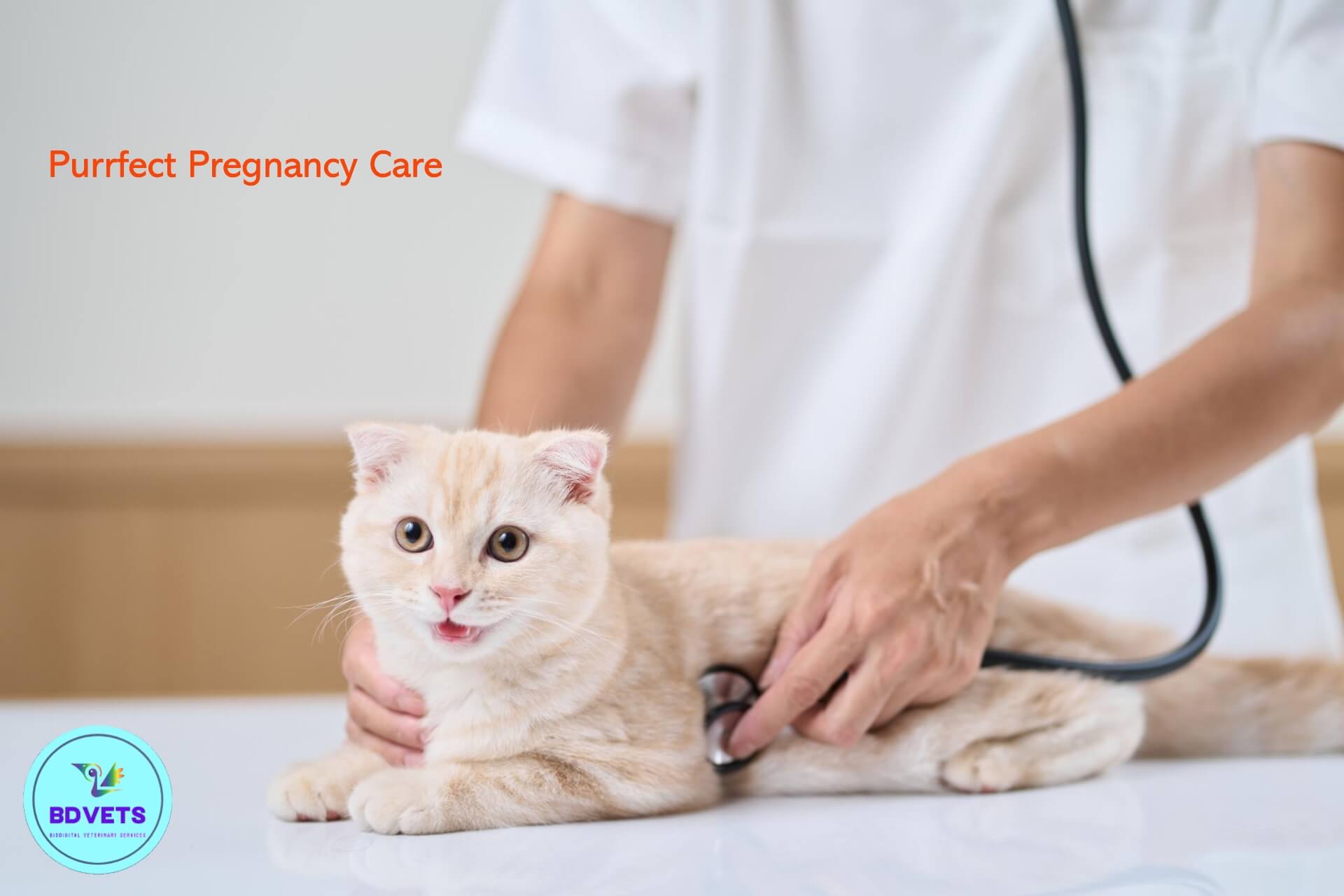🐱 How to Care for a Pregnant Cat: Fostering a
Heavily Pregnant Cat - Tips and Tricks 😺
Caring for a pregnant cat can be rewarding but
also challenging. This comprehensive guide will provide you with everything you
need to know to keep your expectant queen comfortable and give her kittens the
best start in life. 😻
Recognizing the Signs of Pregnancy🤰
How can you tell if your cat is expecting
kittens? Here are some of the most common signs of feline pregnancy to look out
for:
·
Morning sickness - Yes, cats get morning sickness too! You may see vomiting and
loss of appetite in the early stages of pregnancy.😿
·
Enlarged or pink nipples - The nipples will become more prominent and enlarged around 2-3
weeks into the pregnancy as the body prepares for milk production. 🥛
·
Weight gain - Your cat will steadily gain weight during pregnancy as the
kittens grow, usually 1-2 lbs total. Make sure to monitor her diet and avoid
overfeeding. 🍗
·
Enlarged abdomen - In the second half of pregnancy, your cat's belly will visibly
expand as the fetuses enlarge. Her sides may appear square shaped versus
rounded when viewed from above. 🤰
·
Behavioral changes - Increased affection, restlessness, decreased activity and
nesting behaviors like kneading and seeking seclusion may indicate pregnancy. 😾
If you suspect your foster cat is expecting,
schedule a vet visit for confirmation. Ultrasound is the most accurate way to
diagnose feline pregnancy after 15 days from breeding. 👩⚕️
Preparing for the Kittens🛠
Once pregnancy is confirmed, you'll need to
prepare for the big arrival! Here are some tips:
·
Designate a birthing area - This should be a quiet, comfortable and warm place away from
other pets and household activities. A large box, closet or bathroom works
well. 🛏
·
Cat proof the space - Remove any potential hazards and restrict access to cables,
small objects, toxic chemicals or plants that could harm the kittens when they
become mobile. Better safe than sorry! 🔌
·
Stock up on supplies - Have kitten formula, bottles, heating pads, scales, towels,
disinfectant and other essentials ready to go in case of emergency. Your vet
can provide specific recommendations. 🛒
·
Learn warning signs - Educate yourself on signs of birthing complications like
excessive straining or no labor after 24 hours of nesting. Always have your
vet's emergency contact handy. 📞
·
Prepare a veterinary plan - Discuss costs, on-call vets and other details with your clinic
in case medical intervention is needed during labor and delivery. 🏥
With some planning and preparation, you'll be
ready to welcome the new additions when the big day arrives!
Diet and Nutrition🔋
Providing excellent nutrition is crucial for
developing healthy kittens. Follow these dietary guidelines for your expectant
cat:
·
High quality food - Stick to a premium commercial cat food formulated for
pregnancy/growth. Look for high protein (at least 30%) with added calcium,
vitamins and omega fatty acids.💊
·
Increase portions - Starting in week 3-4, gradually increase daily portions to 1.5x
normal intake. Multiple small meals may help if she has morning sickness. She
needs the extra calories! 🍽
·
Unlimited access - Always provide unlimited access to fresh, clean drinking water. Dehydration
risk increases during pregnancy. 💧
·
Supplements - Consult your vet about supplements like taurine for heart health
or collagen for joint support if needed. Avoid over-supplementing. 💊
·
Treats - In moderation, small treats like boiled chicken or meat baby
food can provide extra protein. But avoid junk food! 🍗
·
Routine vet checks - Have your vet examine teeth, weight and general health at
regular intervals during pregnancy. Address any issues promptly. 👩⚕️
With proper nutrition, your foster cat can stay
strong and better nurture her kittens in the womb. Don't hesitate to call your
vet with any feeding questions or concerns.
Litterbox Habits 🚽
As pregnancy progresses, some litterbox
adjustments may be needed:
·
Bigger box - A larger box with lower sides or a cut out entrance can
accommodate a growing belly. 🗑️
·
Easy access - Ensure the box is always in an easy to access spot. Late
pregnancy and post-birth, she may not be able to climb or jump to a high
location. 🐈
·
Extra boxes - Place additional boxes around your home. This saves a long
uncomfortable waddle when she needs to go. 🚽
·
Cleanliness - Scoop clumps 2-3x per day minimum. Change entire litter 2x
weekly. Provide fresh, unscented litter only. She'll be extra sensitive to
smells. 🛀
·
Red flags - Monitor for signs of discomfort, difficulty or bloody urine
which could indicate potentially serious urinary issues. Call the vet promptly
if these arise. 🆘
With diligent litterbox care and access, you can
make this necessity much more comfortable for your expecting cat. Don't be
surprised if she avoids the box entirely as her due date approaches in favor of
other spots. This is normal as she seeks an ideal birthing area. 😾
Grooming and Hygiene 🛁
Grooming is important for comfort and health
during pregnancy. Follow these tips:
·
Brush regularly - Help remove shedding hair and distribute skin oils by gently
brushing with a soft bristle brush. Going easy on mats and tangles. 🪄
·
Bathing - Give occasional gentle baths if needed for cleanliness. Use
small amounts of cat-safe soap and avoid her belly. Ensure she is fully dried. 🛀
·
Nail trims - Clip nails carefully to avoid scratching kittens if she kneads
and nests. Grinding is safer than trimming. 💅
·
Dental care - Get her teeth professionally cleaned to avoid bacteria entering
bloodstream and passing to kittens. Follow up with ongoing home care. 🦷
·
Flea prevention - Use only veterinarian-approved topical flea control in low
dosage. Flea infestations can lead to anemia. 💊
·
Personal space - Respect her privacy and allow her to seclude herself when
nesting. Avoid overhandling or stressful grooming like hair clipping. 🙏
With some common sense grooming, you can keep
your mama cat clean and comfortable without unnecessary stress. Always consult
your vet before using any products or medications during pregnancy. 👍
Exercise and Activity ⚽
While exercise is important, some adjustments
should be made as pregnancy advances:
·
Low impact activity - Stick to short, gentle play and exercise sessions. Avoid
stressful or high exertion exercise. 🏃♀️🚶♀️
·
No roughness - Cats can get hurt more easily when pregnant. Keep other pets
away that may play too roughly. Stop any roughhousing. 🐈🐕
·
Space for movement - Ensure she has room for self-directed exercise and movement,
even if less active than normal. Support natural behaviors. 👍
·
Mental stimulation - Engage her mind with puzzle toys and training sessions. This
supports neurological development in kittens. 🧠
·
Monitor closely - Watch for signs of over-exertion like panting or lameness, which
could endanger pregnancy. When in doubt, let her rest. 😴
While an expectant cat doesn't need forced
exercise routines, continuing appropriate activity can benefit both mother and
kittens. Work closely with your vet to determine safe limits. 🏋️♀️
Stress Reduction and Comfort 😸
Pregnancy brings major physical and hormonal
shifts - help reduce stress for the health of mom and babies:
·
Quiet space - Provide a quiet, dimly lit, cozy space away from noise and
household chaos. This allows undisturbed rest. 😴
·
Routine - Stick to consistent schedules and routines for feeding,
playtime, litter box cleaning. Cats relish predictability! 🗓️
·
Relaxation - Try relaxing techniques like Feliway diffusers, cat-safe
aromatherapy or calming treats. Always run these by your vet first. 😽
·
Massage - Gently pet and massage her in preferred spots - avoiding abdomen
- to ease muscle tension and anxiousness. 💆♀️
·
Patience and love - Allow extra patience for changes in temperament like moodiness
or need for alone time. Give lots of affection! She needs your support. 🥰
·
Vet monitoring - Discuss any concerns about stress levels or anxiety with your
vet. They can provide tailored solutions to keep her Zen. 🧘♀️
With plenty of rest, gentle care and stress
reduction, you'll have a happy mama throughout pregnancy and beyond!
Signs of Labor🤰
As delivery day nears, look for these signs
labor will soon commence:
·
Nesting - She may seek seclusion, vocalize more and refuse to settle in
one spot. Frequent position changes trying to get comfy. 🛏️
·
Decreased appetite - Don't be alarmed if she skips meals or eats less the final days.
Hard contractions make eating uncomfortable. Stay hydrated though! 🍽️
·
Drop in body temp - Her temperature will lower 1-2 degrees Fahrenheit shortly before
labor. Monitor with a thermometer if possible. 🤒
·
Restlessness - She may seem anxious, pace and over-groom. Reassure her! This is
all normal pre-labor behavior. 😿
·
Discharge - A few days prior you may see milky discharge from nipples and
loosening hair around their base as mammary glands prep. 🥛
Go ahead and alert your vet once these signs
emerge! Better to be prepared even if she keeps you waiting another day or two.
Once contractions intensify, birth is imminent. 👍
The Stages of Feline Labor 🤰
Labor consists of 3 main stages:
Stage 1
This initial stage can take 6-36 hours. You'll
observe:
·
Restlessness and nesting urges intensifying
·
Infrequent and mild contractions 10-30 minutes
apart
·
Changes in behavior like vocalizing and clinging
to owners
·
Intermittent vomiting
Reassure her through this prolonged early phase.
Avoid interrupting her quest for an ideal birthing spot.
Stage 2
Active labor lasting 2-24 hours:
·
Contractions are stronger, frequent and
noticeable, 5-60 seconds apart
·
Obvious straining and pushing
·
Rupture of the placental sac and kittens
emerging
This is the most intense stage. Prepare supplies
and notify your vet. Resist the urge to intervene too soon.
Stage 3
Delivery of placentas over 1-8 hours:
·
Delivery of placentas after each individual
kitten
·
Bright red vaginal discharge tapering to pink or
brown tinged
·
Licking kittens to clear fluid from airways and
sever umbilical cord
Doing well so far mama! Clean up placentas as
she eats them to avoid risk of spreading bacteria.
Each birth experience is unique. Always have
your vet's number handy for any concerns or emergencies during labor and
delivery. The average litter is 4-5 kittens. 📞
Newborn Kitten Care 😽
Congratulations - the kittens have arrived!
Caring for newborns requires attentive observation:
Essentials
·
Bedding should be soft blankets or towels,
changed out when soiled
·
Room temperature of 70-80F degrees
·
Rotate separated kittens on and off mom's
nipples each feeding
·
Gentle handling, supporting head and neck
Feeding
·
Nurse frequently, roughly every 1-2 hours
·
Supplement if mom cannot sufficiently nurse
·
Weigh daily and track weight gains
·
Watch for proper nursing position and latch
Hygiene
·
Stimulate genitals before/after nursing with
damp cloth
·
Avoid submerging in water or bathing yet
Vet
Checks
·
Initial exam within 24 hours checking vitals and
weight
·
Deworming and vaccines per vet's schedule
·
Spay/neuter once weaned, around 8-12 weeks old
With round-the-clock care and attention during
these first vulnerable weeks, you're giving the kittens the absolute best
start! 😻
Weaning Kittens 🍼
Around 3-4 weeks old, kittens will begin
naturally weaning from nursing:
·
Gradual process - Mom will encourage independence. Kittens take interest in solid
foods.
·
Supplement feeding - Provide wet and dry kitten food, increased at a careful pace.
·
Teach litter habits - Place kittens in box after feeding so they associate. Praise
successes!
·
Socialization - Safely expose kittens to new sights, sounds and handling by 8
weeks old.
·
Full weaning - Kittens are typically fully weaned between 8-12 weeks as
nutrition needs shift.
Consult your vet on optimal supplemental feeding
schedules, nutrition needs and debuting solid foods. With patience, the weaning
process will complete naturally.
Congratulations! 🎉
You did it! With proper preparation, diligent
care and attention, your foster cat and kittens made it through pregnancy and
birth. Now the real fun begins - watching the kittens grow and develop into
healthy, friendly and adoptable furballs ready to bring joy to new families!
Bask in your foster parenting success. 🥳
Recap of Key Pregnancy Cat Care Tips:
·
Prepare birthing area, supplies and vet plan
ahead of time
·
Feed high quality nutrition and monitor weight
·
Provide ideal litterbox setup throughout term
·
Groom gently and keep fleas away
·
Allow rest and provide a calm environment
·
Watch for labor signs as due date nears
·
Closely monitor mom and newborns, get vet exam
·
Assist gradual weaning around 3-4 weeks old
·
Socialize kittens for adoption success!
We hope this guide gives you confidence tackling
cat pregnancy and fostering new life! Let us know if you have any other
fostering questions. 🐈


















